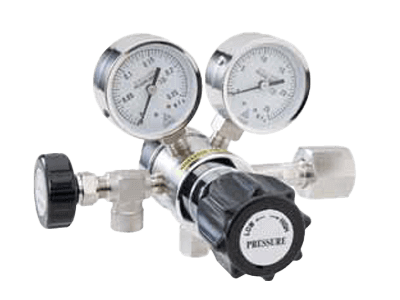What Is a Pressure Regulator?

A pressure regulator is a device used to adjust the pressure of compressed gases, liquids, and other fluids.
Normally, gases and pumped fluids filled in pressure-resistant vessels are at dangerously high pressures when used as they are, so it is necessary to control the discharge pressure according to the application in which they are used. In addition, when re-pressurizing or re-filling the container in accordance with the filling volume, it is necessary to control the pressure inside the container. This is done with a pressure regulator so that the pressure inside the pressure-resistant container does not exceed the allowable value.
Uses of Pressure Regulators
In this case, a “backfire prevention valve” is installed on the secondary side to prevent flashback (flames reaching back inside the cylinder and exploding) in the event of a backfire. Oxygen cylinders used for scuba diving are also used to supply a constant pressure of oxygen to divers. In addition, metering pumps use back-pressure valves to prevent fluid inertia and siphon phenomenon, and always pump a constant volume and constant pressure of fluid.
Features of Pressure Regulators
There are two main types of pressure regulators: those that regulate the primary side (inlet side) pressure and those that regulate the secondary side (outlet side) pressure, the former being called a “back pressure valve” and the latter a “pressure reducing valve.”
The former is called a “back pressure valve” and the latter is called a “pressure reducing valve.” Both valves use the spring rate (spring stress) and fluid pressure in the regulator and are controlled by the balance between the two.
Although back pressure valves and safety valves work in a very similar way, the purpose of safety valves is to protect facilities by lowering the pressure below a predetermined value, while the purpose of back pressure valves is to “maintain the pressure in the vessel/piping”.
In addition, in the case of a self-supporting pressure reducing valve, when the pressure on the primary side drops, the discharge pressure on the secondary side may rise (by 1-2% of the primary fluctuation). To prevent this, there is a two-stage pressure reducing valve that reduces pressure in two stages. For example, in the case of a valve with a secondary-side fluctuation rate of 1.5%, the fluctuation rate can be reduced to 0.0225% (1.5% x 1.5%).